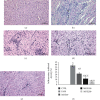Melissa officinalis L. Supplementation Provides Cardioprotection in a Rat Model of Experimental Autoimmune Myocarditis
- PMID: 35265259
- PMCID: PMC8901324
- DOI: 10.1155/2022/1344946
Melissa officinalis L. Supplementation Provides Cardioprotection in a Rat Model of Experimental Autoimmune Myocarditis
Abstract
Due to existing evidence regarding antioxidant and anti-inflammatory effects of Melissa officinalis extracts (MOEs), this study was aimed at investigating the potential of ethanolic MOE to prevent the development of myocarditis and its ability to ameliorate the severity of experimental autoimmune myocarditis (EAM) by investigating MOE effects on in vivo cardiac function, structure, morphology, and oxidative stress parameters. A total of 50 7-week-old male Dark Agouti rats were enrolled in the study and randomly allocated into the following groups: CTRL, nontreated healthy rats; EAM, nontreated rats with EAM; MOE50, MOE100, and MOE200, rats with EAM treated with either 50, 100, or 200 mg/kg of MOE for 3 weeks per os. Myocarditis was induced by immunization of the rats with porcine myocardial myosin (0.5 mg) emulsion on day 0. Cardiac function and dimensions of the left ventricle (LV) were assessed via echocardiography. Additionally, the blood pressure and heart rate were measured. On day 21, rats were sacrificed and the hearts were isolated for further histopathological analyses (H/E and Picrosirius red staining). The blood samples were collected to determine oxidative stress parameters. The EAM group characteristically showed greater LV wall thickness and lower ejection fraction (50.33 ± 7.94% vs. 84.81 ± 7.74%) and fractional shortening compared to CTRL (p < 0.05). MOE significantly improved echocardiographic parameters (EF in MOE200 81.44 ± 5.51%) and also reduced inflammatory infiltrate (by 88.46%; p < 0.001) and collagen content (by 76.39%; p < 0.001) in the heart tissues, especially in the MOE200 group compared to the EAM group. In addition, MOEs induced a significant decrease of prooxidants production (O2 -, H2O2, and TBARS) and improved antioxidant defense system via increase in GSH, SOD, and CAT compared to EAM, with medium and high dose being more effective than low dose (p < 0.05). The present study suggests that ethanolic MOEs, especially in a 200 mg/kg dose, improve cardiac function and myocardial architecture, possibly via oxidative stress mitigation, thus preventing heart remodeling, development of dilated cardiomyopathy, and subsequent heart failure connected with EAM. MOEs might be considered as a potentially helpful adjuvant therapy in patients with autoimmune myocarditis.
Copyright © 2022 Nevena D. Draginic et al.
Conflict of interest statement
The authors declare that they have no conflict of interest regarding the publication of this paper.
Figures






Similar articles
-
Quercetin ameliorates experimental autoimmune myocarditis in rats.J Pharm Pharm Sci. 2010;13(3):311-9. doi: 10.18433/j3vs3s. J Pharm Pharm Sci. 2010. PMID: 21092705
-
ET-1 receptor type B (ETBR) overexpression associated with ICAM-1 downregulation leads to inflammatory attenuation in experimental autoimmune myocarditis.PeerJ. 2023 Oct 24;11:e16320. doi: 10.7717/peerj.16320. eCollection 2023. PeerJ. 2023. PMID: 37901475 Free PMC article.
-
Emodin, a naturally occurring anthraquinone, ameliorates experimental autoimmune myocarditis in rats.Tohoku J Exp Med. 2012 Jul;227(3):225-30. doi: 10.1620/tjem.227.225. Tohoku J Exp Med. 2012. PMID: 22791134
-
Regulation of inflammation and myocardial fibrosis in experimental autoimmune myocarditis.Inflamm Allergy Drug Targets. 2011 Jun;10(3):218-25. doi: 10.2174/187152811795564091. Inflamm Allergy Drug Targets. 2011. PMID: 21495969 Review.
-
Natural products with anti-inflammatory and immunomodulatory activities against autoimmune myocarditis.Pharmacol Res. 2017 Oct;124:34-42. doi: 10.1016/j.phrs.2017.07.022. Epub 2017 Jul 27. Pharmacol Res. 2017. PMID: 28757189 Review.
Cited by
-
Measurement of blood pressure in rats: Invasive or noninvasive methods?Physiol Rep. 2024 Sep;12(17):e70041. doi: 10.14814/phy2.70041. Physiol Rep. 2024. PMID: 39266877 Free PMC article. Review.
-
Modulation of TLR4/NFκB Pathways in Autoimmune Myocarditis.Antioxidants (Basel). 2023 Jul 27;12(8):1507. doi: 10.3390/antiox12081507. Antioxidants (Basel). 2023. PMID: 37627502 Free PMC article.
-
The Valorisation of Melissa officinalis Distillation By-Products for the Production of Polyphenol-Rich Formulations.Molecules. 2024 Jan 11;29(2):377. doi: 10.3390/molecules29020377. Molecules. 2024. PMID: 38257290 Free PMC article.
-
Short-Term Administration of Lemon Balm Extract Ameliorates Myocardial Ischemia/Reperfusion Injury: Focus on Oxidative Stress.Pharmaceuticals (Basel). 2022 Jul 8;15(7):840. doi: 10.3390/ph15070840. Pharmaceuticals (Basel). 2022. PMID: 35890139 Free PMC article.
-
Aggravation of TGFβ1-Smad Pathway and Autoimmune Myocarditis by Fungicide (Tebuconazole) Exposure.Int J Mol Sci. 2023 Jul 15;24(14):11510. doi: 10.3390/ijms241411510. Int J Mol Sci. 2023. PMID: 37511266 Free PMC article.
References
MeSH terms
LinkOut - more resources
Full Text Sources
Medical
Miscellaneous

